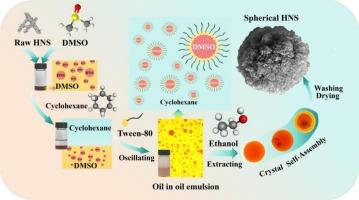微纳二级结构球形HNS的性能增强控制制备
IF 4.6
2区 工程技术
Q2 ENGINEERING, CHEMICAL
引用次数: 0
摘要
具有微纳二级结构的球形含能材料在航空航天、国防和军事等领域具有广阔的应用前景。本文以吐温-80为表面活性剂,二甲基亚砜(DMSO)为溶剂油相,环己烷为非溶剂油相,采用油包油乳化法制备了具有微纳二级结构的球形HNS。考察了表面活性剂的种类和浓度、溶剂与非溶剂比、乳状液静置时间对乳状液稳定性的影响。采用扫描电子显微镜(SEM)、x射线粉末衍射(XRD)、傅里叶变换红外光谱(FT-IR)、差示扫描量热法(DSC)和热重分析(TG)对球形HNS的形貌、晶体结构和热分解性能进行了表征。对原始HNS和球形HNS的燃烧性能、机械灵敏度和短脉冲起爆性能进行了测试和比较。结果表明,以吐温-80为表面活性剂,当吐温-80的浓度为5 g·L−1,溶剂与非溶剂体积比为3:3,静置时间小于30 min时,可得到粒径均匀、分散性好的球形HNS。与原料相比,球形HNS的热分解峰温度提前15.5℃,燃烧性能得到改善。球形HNS的比表面积扩大了15倍,具有良好的不敏感效果和优良的短脉冲爆轰性能。本文章由计算机程序翻译,如有差异,请以英文原文为准。

Controlled fabrication of spherical HNS with Micro/Nano secondary structure for performance augmentation
Spherical energetic materials with micro-nano secondary structure have broad application prospects in the fields of aerospace, defense and military. In this paper, spherical HNS with micro-nano secondary structure was prepared by oil-in-oil emulsion method with Tween-80 as surfactant, dimethyl sulfoxide (DMSO) as solvent oil phase and cyclohexane as non-solvent oil phase. The effects of surfactant type and concentration, solvent-nonsolvent ratio and emulsion standing time on emulsion stability were investigated. The morphology, crystal structure and thermal decomposition properties of spherical HNS were characterized by scanning electron microscopy (SEM), X-ray powder diffraction (XRD), Fourier transform infrared spectroscopy (FT-IR), differential scanning calorimetry (DSC) and thermogravimetric analysis (TG). The combustion performance, mechanical sensitivity and short pulse initiation performance of raw HNS and spherical HNS were tested and compared. The results showed that spherical HNS with uniform particle size and good dispersion could be obtained when Tween-80 was used as surfactant, the concentration was 5 g·L−1, the volume ratio of solvent to non-solvent was 3:3, and the standing time was less than 30 min.Compared with the raw materials, the thermal decomposition peak temperature of spherical HNS was 15.5 °C earlier, and the combustion performance was improved. The specific surface area of spherical HNS was expanded by 15 times, showing good insensitive effect and excellent short pulse detonation performance.
求助全文
通过发布文献求助,成功后即可免费获取论文全文。
去求助
来源期刊

Powder Technology
工程技术-工程:化工
CiteScore
9.90
自引率
15.40%
发文量
1047
审稿时长
46 days
期刊介绍:
Powder Technology is an International Journal on the Science and Technology of Wet and Dry Particulate Systems. Powder Technology publishes papers on all aspects of the formation of particles and their characterisation and on the study of systems containing particulate solids. No limitation is imposed on the size of the particles, which may range from nanometre scale, as in pigments or aerosols, to that of mined or quarried materials. The following list of topics is not intended to be comprehensive, but rather to indicate typical subjects which fall within the scope of the journal's interests:
Formation and synthesis of particles by precipitation and other methods.
Modification of particles by agglomeration, coating, comminution and attrition.
Characterisation of the size, shape, surface area, pore structure and strength of particles and agglomerates (including the origins and effects of inter particle forces).
Packing, failure, flow and permeability of assemblies of particles.
Particle-particle interactions and suspension rheology.
Handling and processing operations such as slurry flow, fluidization, pneumatic conveying.
Interactions between particles and their environment, including delivery of particulate products to the body.
Applications of particle technology in production of pharmaceuticals, chemicals, foods, pigments, structural, and functional materials and in environmental and energy related matters.
For materials-oriented contributions we are looking for articles revealing the effect of particle/powder characteristics (size, morphology and composition, in that order) on material performance or functionality and, ideally, comparison to any industrial standard.
 求助内容:
求助内容: 应助结果提醒方式:
应助结果提醒方式:


